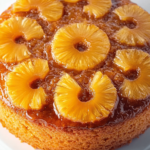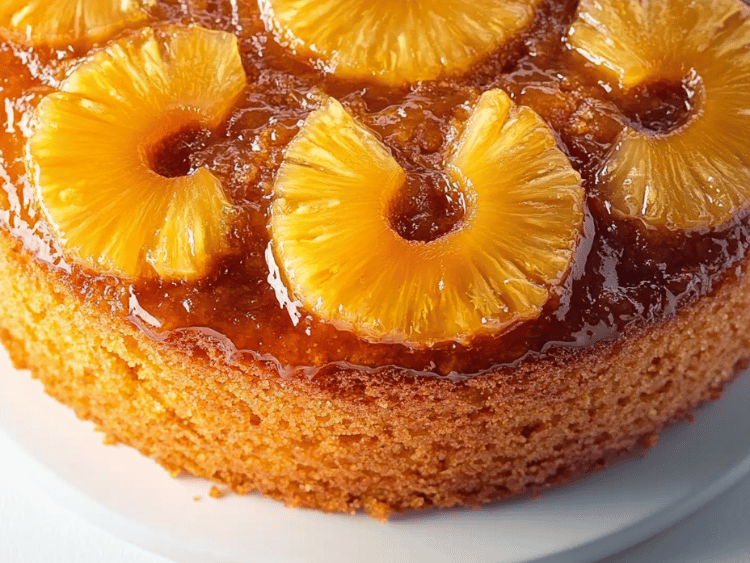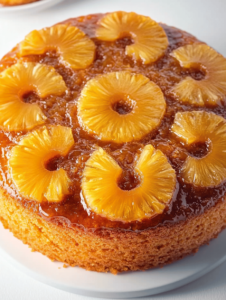Introduction
There’s something undeniably nostalgic about a pineapple upside-down cake. This classic dessert, with its caramelized pineapple rings and cherries atop a moist, buttery cake, has been a favorite for generations. The combination of sweet and tangy flavors, coupled with the visually stunning presentation, makes it a showstopper at any gathering. Whether you’re baking for a special occasion, a family dinner, or simply craving a sweet treat, this recipe for the best pineapple upside-down cake is sure to impress both in taste and appearance.
In this article, we’ll guide you through each step to create a cake that’s not only delicious but also visually stunning. From selecting the right ingredients to mastering the baking process, we’ll cover everything you need to know. Even if you’re a novice baker, this comprehensive guide will make the process approachable and enjoyable. So, let’s dive into the world of sweet pineapples, sticky caramel, and fluffy cake, and create a dessert that’s bound to become a household favorite!
Ingredients
One of the secrets to making the best pineapple upside-down cake lies in using high-quality ingredients. Here’s what you’ll need:
For the Topping:
1/2 cup (1 stick) unsalted butter: Provides richness and helps create the caramel topping.
1 cup packed brown sugar: Adds sweetness and depth of flavor; brown sugar caramelizes beautifully.
7-9 slices canned pineapple rings (reserve juice): The star of the show; choose rings packed in juice, not syrup, for the best flavor.
Maraschino cherries (optional, about 7-9): Adds a pop of color and additional sweetness.
1/2 cup chopped pecans or walnuts (optional): Introduces a crunchy texture and nutty flavor.
For the Cake:
1 and 3/4 cups all-purpose flour: The foundation of the cake’s structure.
2 teaspoons baking powder: Helps the cake rise, making it light and fluffy.
1/4 teaspoon salt: Enhances the flavors and balances sweetness.
1/2 cup (1 stick) unsalted butter, softened: Adds moisture and richness to the cake.
1 cup granulated sugar: Sweetens the cake batter.
2 large eggs: Bind the ingredients together and provide structure.
1 teaspoon pure vanilla extract: Adds aromatic flavor.
1/2 cup whole milk: Moistens the batter and contributes to a tender crumb.
1/4 cup pineapple juice (reserved from canned pineapples): Infuses the cake with pineapple flavor.
Instructions
Creating this delightful cake involves a series of steps that are easy to follow. Let’s get started!
Step 1: Preheat the Oven
Begin by preheating your oven to 350°F (175°C). Position a rack in the center of the oven to ensure even baking. Preheating is crucial for proper cake rise and texture.
Step 2: Prepare the Topping
Melt the Butter: In a small saucepan over low heat, melt 1/2 cup of unsalted butter. Be careful not to burn it.
Add Brown Sugar: Once the butter is melted, add 1 cup of packed brown sugar to the saucepan.
Combine: Stir the mixture continuously until the sugar dissolves and the mixture is smooth and bubbly, about 2-3 minutes.
Pour into Pan: Carefully pour the sugar mixture into a 9-inch round cake pan. Tilt the pan gently to ensure the mixture coats the entire bottom evenly.
Step 3: Arrange the Pineapple and Cherries
Place Pineapple Rings: Arrange the pineapple rings over the brown sugar mixture. Start with one ring in the center and place the remaining rings in a circular pattern around it.
Add Cherries: If using maraschino cherries, place one cherry in the center of each pineapple ring and in the spaces between the rings for added color and flavor.
Sprinkle Nuts: For extra texture, sprinkle 1/2 cup of chopped pecans or walnuts over the pineapples and cherries. This step is optional but highly recommended for nut lovers.
Step 4: Prepare the Cake Batter
Combine Dry Ingredients: In a medium-sized bowl, whisk together 1 and 3/4 cups of all-purpose flour, 2 teaspoons of baking powder, and 1/4 teaspoon of salt. This ensures the leavening agent and salt are evenly distributed.
Cream Butter and Sugar: In a large mixing bowl, use an electric mixer to beat 1/2 cup of softened unsalted butter until creamy.
Add Sugar: Gradually add 1 cup of granulated sugar to the butter, continuing to beat until the mixture is light and fluffy, about 2 minutes. This process incorporates air, which is essential for a light cake.
Incorporate Eggs: Add the 2 large eggs to the butter-sugar mixture one at a time, beating well after each addition. This helps maintain the emulsion and prevents the batter from curdling.
Add Vanilla: Mix in 1 teaspoon of pure vanilla extract to enhance the overall flavor.
Step 5: Combine Wet and Dry Ingredients
Alternate Additions: Gradually add the dry ingredient mixture to the wet ingredients in three parts, alternating with the 1/2 cup of milk and 1/4 cup of pineapple juice. This means you’ll add a portion of the dry ingredients, then some milk and juice, then repeat.
Mix Gently: After each addition, mix until just combined. Overmixing can develop gluten in the flour, resulting in a tougher cake.
Scrape the Bowl: Use a spatula to scrape down the sides and bottom of the bowl to ensure all ingredients are fully incorporated.
Step 6: Pour the Batter Over the Topping
Add Batter to Pan: Carefully pour the prepared cake batter over the arranged pineapple and cherries in the cake pan.
Even Out the Batter: Use a spatula to spread the batter evenly, ensuring it reaches all edges and covers the fruit completely.
Step 7: Bake the Cake
Bake: Place the cake pan in the preheated oven.
Monitor: Bake for 45-50 minutes. Since oven temperatures can vary, start checking the cake at the 40-minute mark.
Test for Doneness: Insert a toothpick or cake tester into the center of the cake. If it comes out clean or with a few moist crumbs, the cake is done.
Check the Color: The top of the cake should be a lovely golden brown.
Step 8: Cool and Invert the Cake
Initial Cooling: Remove the cake from the oven and place it on a wire rack. Allow it to cool in the pan for about 15 minutes. This cooling period is crucial to let the caramel topping set slightly but still remain fluid enough to release.
Loosen the Edges: Run a knife or spatula around the edges of the pan to loosen the cake.
Invert the Cake: Place a serving plate or cake stand upside down over the pan. Using oven mitts, hold the pan and plate firmly together and flip them over in one swift motion.
Reveal the Topping: Gently lift the pan away. The pineapple and caramel topping should now adorn the top of the cake, creating a beautiful presentation.
Final Cooling: Allow the cake to cool completely before slicing. This helps the cake set and makes it easier to cut clean slices.
Tips
To ensure your pineapple upside-down cake turns out perfectly every time, consider these helpful tips:
Use Room Temperature Ingredients: Bringing ingredients like butter, eggs, and milk to room temperature allows them to combine more easily, resulting in a smoother batter and a more tender cake.
Choose the Right Pineapple: While canned pineapple rings are traditional and convenient, using fresh pineapple can enhance the flavor. If you opt for fresh, slice the pineapple thinly and consider adjusting the sugar in the topping if the pineapple is particularly sweet.
Prevent Overmixing: Overmixing the batter can develop too much gluten, leading to a dense cake. Mix just until the ingredients are combined.
Check Oven Accuracy: If your cakes often come out under or overcooked, consider using an oven thermometer to ensure your oven is heating to the correct temperature.
Customize the Topping: Feel free to experiment with different fruits like peaches, pears, or apples for a unique twist on this classic recipe.
Line the Pan: If you’re concerned about the cake sticking, you can line the bottom of the pan with parchment paper before adding the butter and sugar mixture.
Serving Suggestions
Elevate your pineapple upside-down cake experience with these serving ideas:
Warm and A La Mode: Serve the cake slightly warm with a generous scoop of vanilla ice cream. The contrast between the warm cake and cold ice cream is delightful.
Whipped Cream Delight: Top each slice with a dollop of freshly whipped cream. For an extra touch, sprinkle a little cinnamon or nutmeg over the cream.
Tropical Flair: Garnish with toasted coconut flakes to enhance the tropical flavors.
Beverage Pairings: Enjoy a slice with a cup of hot coffee or tea. Alternatively, pair it with a glass of dessert wine or a fruity cocktail for an adult treat.
Festive Presentation: Dust the cake lightly with powdered sugar just before serving for an elegant look.
Storage
Proper storage ensures your cake remains fresh and delicious:
At Room Temperature: The cake can be stored at room temperature, covered, for up to two days. Use a cake dome or airtight container to prevent it from drying out.
In the Refrigerator: For extended freshness, refrigerate the cake for up to five days. Wrap it tightly with plastic wrap or place it in an airtight container.
Freezing Instructions: To freeze, wrap individual slices tightly in plastic wrap and place them in a freezer-safe bag or container. Freeze for up to three months.
Thawing and Reheating: Thaw frozen slices in the refrigerator overnight or at room temperature for a couple of hours. To reheat, warm the cake slices in the microwave for 15-20 seconds or in a preheated oven at 300°F (150°C) for about 10 minutes.
FAQ
Q1: Can I use a different type of flour, like whole wheat or almond flour?
A: While you can substitute some of the all-purpose flour with whole wheat flour for a heartier texture, it’s best not to replace all of it, as this can make the cake dense. Almond flour behaves differently and would require recipe adjustments.
Q2: What if I don’t have brown sugar?
A: If you don’t have brown sugar, you can make a substitute by mixing 1 cup of granulated sugar with 1 tablespoon of molasses. This mixture will mimic the moisture and flavor of brown sugar.
Q3: Can I make this cake dairy-free?
A: Yes! Substitute the butter with a dairy-free margarine or coconut oil, and use a non-dairy milk like almond or soy milk. Ensure your substitutions are suitable for baking.
Q4: How do I prevent the cake from becoming soggy?
A: Ensure you drain the pineapple slices well before arranging them in the pan. Excess liquid can make the cake soggy. Also, don’t overpour the pineapple juice into the batter; measure it accurately.
Q5: Is it possible to make mini pineapple upside-down cakes?
A: Absolutely! You can use a muffin tin or mini cake pans. Adjust the baking time to approximately 20-25 minutes, but keep an eye on them, as smaller cakes bake faster.
Q6: Can I reduce the sugar in the recipe?
A: You can reduce the granulated sugar in the cake batter by up to 1/4 cup without significantly affecting the texture. Reducing the sugar in the topping isn’t recommended, as it may affect the caramelization.
Q7: What causes the cake to stick to the pan, and how can I avoid it?
A: Sticking can occur if the sugar mixture isn’t evenly spread or if the cake isn’t properly loosened before inverting. To avoid this, ensure the topping covers the entire bottom of the pan and run a knife around the edges before flipping.
Q8: Why did my cake sink in the middle?
A: A sinking cake can result from underbaking, opening the oven door too early, or overmixing the batter. Ensure you bake the cake until it’s fully cooked and avoid unnecessary movement during baking.
Q9: Can I add spices to the cake batter?
A: Yes! Adding spices like cinnamon, nutmeg, or ginger can enhance the flavor. Start with 1/2 teaspoon and adjust to your taste.
Q10: How can I tell if my cake is overbaked?
A: An overbaked cake may have a dry texture and a dark crust. To prevent overbaking, start checking for doneness a few minutes before the minimum baking time.
Conclusion
Baking the best pineapple upside-down cake is a delightful experience that combines simple ingredients to create something truly special. This cake is more than just a dessert; it’s a piece of culinary history that has been enjoyed for generations. With its moist crumb, caramelized topping, and vibrant fruit, it’s sure to be a hit whether you’re serving it at a festive gathering or enjoying a slice on a quiet afternoon.
We hope this comprehensive guide has provided you with all the information you need to bake a perfect pineapple upside-down cake. Remember, baking is both an art and a science, so don’t be afraid to make this recipe your own by adding personal touches. Happy baking, and may your cake turn out as wonderful as you envisioned!
Print
The Best Pineapple Upside-Down Cake
Description
This Pineapple Upside-Down Cake is the ultimate classic dessert that combines a moist, buttery cake with a deliciously caramelized pineapple topping. The juicy pineapple rings and maraschino cherries not only add a burst of tropical flavor but also create a stunning presentation that’s sure to impress. Perfect for any occasion, this easy-to-follow recipe will guide you in making a show-stopping cake that’s as delightful to look at as it is to eat.
Ingredients
For the Topping:
½ cup (1 stick) unsalted butter
1 cup packed brown sugar
7–9 canned pineapple rings (reserve juice)
7–9 maraschino cherries
½ cup chopped pecans or walnuts (optional)
For the Cake Batter:
1¾ cups all-purpose flour
2 teaspoons baking powder
¼ teaspoon salt
½ cup (1 stick) unsalted butter, softened
1 cup granulated sugar
2 large eggs
1 teaspoon pure vanilla extract
½ cup whole milk
¼ cup pineapple juice (reserved from canned pineapples)
Instructions
Preheat the Oven:
Preheat your oven to 350°F (175°C). Position the oven rack in the middle.
Prepare the Topping:
In a small saucepan over low heat, melt ½ cup of unsalted butter.
Stir in 1 cup of packed brown sugar until it dissolves and the mixture is smooth, about 2-3 minutes.
Pour the mixture into a 9-inch round cake pan, tilting to coat the bottom evenly.
Arrange the Pineapple and Cherries:
Place 1 pineapple ring in the center of the pan.
Arrange the remaining pineapple rings around the center one.
Place a maraschino cherry in the center of each pineapple ring and in between the rings if desired.
Sprinkle ½ cup of chopped pecans or walnuts over the fruit if using.
Prepare the Cake Batter:
In a medium bowl, whisk together 1¾ cups of all-purpose flour, 2 teaspoons of baking powder, and ¼ teaspoon of salt. Set aside.
In a large mixing bowl, beat ½ cup of softened unsalted butter with an electric mixer until creamy.
Gradually add 1 cup of granulated sugar, beating until light and fluffy.
Add 2 large eggs, one at a time, beating well after each addition.
Mix in 1 teaspoon of pure vanilla extract.
Combine Wet and Dry Ingredients:
In a measuring cup, combine ½ cup of whole milk and ¼ cup of reserved pineapple juice.
Gradually add the dry ingredient mixture to the butter mixture in three parts, alternating with the milk-pineapple juice mixture, beginning and ending with the dry ingredients.
Mix until just combined after each addition.
Assemble the Cake:
Carefully pour the batter over the arranged pineapples and cherries in the pan.
Smooth the top with a spatula to ensure even baking.
Bake the Cake:
Bake in the preheated oven for 45-50 minutes, or until a toothpick inserted into the center of the cake comes out clean.
If the top of the cake browns too quickly, tent it with aluminum foil during the last 10 minutes of baking.
Cool and Invert:
Remove the cake from the oven and let it cool in the pan on a wire rack for 15 minutes.
Run a knife around the edge of the pan to loosen the cake.
Place a serving plate upside down over the pan, then carefully invert the pan and plate together.
Gently lift the pan to reveal the pineapple topping.
Serve:
Allow the cake to cool slightly before slicing.
Serve warm or at room temperature.
Enjoy your delicious Pineapple Upside-Down Cake!


